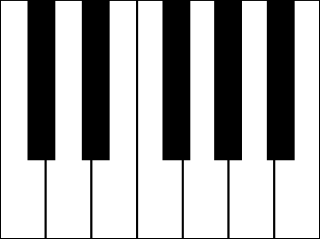
The chromatic scale is a set of twelve pitches used in tonal music, with notes separated by the interval of a semitone. Almost all western musical instruments, such as the piano, are made to produce the chromatic scale, while other instruments capable of continuously variable pitch, such as the trombone and violin, can also produce microtones, or notes between those available on a piano.

In music, timbre, also known as tone color or tone quality, is the perceived sound quality of a musical note, sound or tone. Timbre distinguishes different types of sound production, such as choir voices and musical instruments. It also enables listeners to distinguish different instruments in the same category.
Color depth or colour depth, also known as bit depth, is either the number of bits used to indicate the color of a single pixel, or the number of bits used for each color component of a single pixel. When referring to a pixel, the concept can be defined as bits per pixel (bpp). When referring to a color component, the concept can be defined as bits per component, bits per channel, bits per color, and also bits per pixel component, bits per color channel or bits per sample (bps). Modern standards tend to use bits per component, but historical lower-depth systems used bits per pixel more often.

The CIELAB color space, also referred to as L*a*b*, is a color space defined by the International Commission on Illumination in 1976. It expresses color as three values: L* for perceptual lightness, and a* and b* for the four unique colors of human vision: red, green, blue, and yellow. CIELAB was intended as a perceptually uniform space, where a given numerical change corresponds to a similar perceived change in color. While the LAB space is not truly perceptually uniform, it nevertheless is useful in industry for detecting small differences in color.

In color reproduction, including computer graphics and photography, the gamut, or color gamut, is a certain complete subset of colors. The most common usage refers to the subset of colors which can be accurately represented in a given circumstance, such as within a given color space or by a certain output device.
In music, a hexachord is a six-note series, as exhibited in a scale or tone row. The term was adopted in this sense during the Middle Ages and adapted in the 20th century in Milton Babbitt's serial theory. The word is taken from the Greek: ἑξάχορδος, compounded from ἕξ and χορδή, and was also the term used in music theory up to the 18th century for the interval of a sixth.

sRGB is a standard RGB color space that HP and Microsoft created cooperatively in 1996 to use on monitors, printers, and the World Wide Web. It was subsequently standardized by the International Electrotechnical Commission (IEC) as IEC 61966-2-1:1999. sRGB is the current defined standard colorspace for the web, and it is usually the assumed colorspace for images that are neither tagged for a colorspace nor have an embedded color profile.
In music, the Phrygian dominant scale is the fifth mode of the harmonic minor scale, the fifth being the dominant. Also called the altered Phrygian scale, dominant flat 2 flat 6 (in jazz), the Freygish scale (also spelled Fraigish), harmonic dominant, or simply the fifth mode of the harmonic minor scale. It resembles the scale of the Phrygian mode but has a major third. In the Berklee method, it is known as the Mixolydian ♭9 ♭13 chord scale, a Mixolydian scale with a lowered 9th (2nd) and lowered 13th (6th), used in secondary dominant chord scales for V7/III and V7/VI. Bebop jazz pianist Barry Harris added a note to the scale and describes his use as "on C7, play down from the 7th of Eb7 to E the 3rd of C7” and especially over G-7b5 to C7b9 (the ii V in minor). He nicknamed this eight tone scale “the minor’s five”. Being eight tones it has the advantage of placing the chord tones on the beats which enables a melody to reinforce the underlying harmony. It also eliminates the harsh augmented 2nd melodic interval found in the seven tone 5th mode of harmonic minor scale. Another advantage is that gives improvisers an access to their often more familiar dominant scale vocabulary. Barry Harris further recognized that its descending form has an especially melodic quality rather than being played up from a root. He said he noticed this particular descending permutation being played by Charlie Parker several times on “What Is This Thing Called Love?”.

Cox Enterprises, Inc. is a privately held global conglomerate headquartered in Atlanta, Georgia, United States, with approximately 55,000 employees and $21 billion in total revenue. Its major operating subsidiaries are Cox Communications, Cox Automotive, and Cox Media Group. The company's major national brands include AutoTrader, Kelley Blue Book and more.

In medieval music, the Guidonian hand was a mnemonic device used to assist singers in learning to sight-sing. Some form of the device may have been used by Guido of Arezzo, a medieval music theorist who wrote a number of treatises, including one instructing singers in sightreading. The hand occurs in some manuscripts before Guido's time as a tool to find the semitone; it does not have the depicted form until the 12th century. Sigebertus Gemblacensis in c. 1105–1010 did describe Guido using the joints of the hand to aid in teaching his hexachord. The Guidonian hand is closely linked with Guido's new ideas about how to learn music, including the use of hexachords, and the first known Western use of solfège.
Logluv TIFF is an encoding used for storing high-dynamic-range imaging data inside a TIFF image. It was originally developed by Greg Ward for storing HDR-output of his Radiance-photonmapper at a time where storage space was a crucial factor. Its implementation in TIFF also allowed the combination with image-compression algorithms without great programming effort. As such it has to be considered a smart compromise between the imposed limitations. It is slightly related to RGBE, the most successful HDRI storage format, an earlier invention of Greg Ward.
xvYCC or extended-gamut YCbCr is a color space that can be used in the video electronics of television sets to support a gamut 1.8 times as large as that of the sRGB color space. xvYCC was proposed by Sony, specified by the IEC in October 2005 and published in January 2006 as IEC 61966-2-4. xvYCC extends the ITU-R BT.709 tone curve by defining over-ranged values. xvYCC-encoded video retains the same color primaries and white point as BT.709, and uses either a BT.601 or BT.709 RGB-to-YCC conversion matrix and encoding. This allows it to travel through existing digital limited range YCC data paths, and any colors within the normal gamut will be compatible. It works by allowing negative RGB inputs and expanding the output chroma. These are used to encode more saturated colors by using a greater part of the RGB values that can be encoded in the YCbCr signal compared with those used in Broadcast Safe Level. The extra-gamut colors can then be displayed by a device whose underlying technology is not limited by the standard primaries.

Diatonic and chromatic are terms in music theory that are most often used to characterize scales, and are also applied to musical instruments, intervals, chords, notes, musical styles, and kinds of harmony. They are very often used as a pair, especially when applied to contrasting features of the common practice music of the period 1600–1900.
Shí-èr-lǜ was a standardized gamut of twelve notes. Also known, rather misleadingly, as the Chinese chromatic scale, it was one kind of chromatic scale used in ancient Chinese music. The Chinese scale uses the same intervals as the Pythagorean scale, based on 3:2 ratios. The gamut or its subsets were used for tuning and are preserved in bells and pipes.

Multi-scale camouflage is a type of military camouflage combining patterns at two or more scales, often with a digital camouflage pattern created with computer assistance. The function is to provide camouflage over a range of distances, or equivalently over a range of scales, in the manner of fractals, so some approaches are called fractal camouflage. Not all multiscale patterns are composed of rectangular pixels, even if they were designed using a computer. Further, not all pixellated patterns work at different scales, so being pixellated or digital does not of itself guarantee improved performance.

A color space is a specific organization of colors. In combination with color profiling supported by various physical devices, it supports reproducible representations of color -- whether such representation entails an analog or a digital representation. A color space may be arbitrary, i.e. with physically realized colors assigned to a set of physical color swatches with corresponding assigned color names, or structured with mathematical rigor. A "color space" is a useful conceptual tool for understanding the color capabilities of a particular device or digital file. When trying to reproduce color on another device, color spaces can show whether you will be able to retain shadow/highlight detail, color saturation, and by how much either will be compromised.

CMG Media Corporation is an American media conglomerate principally owned by Apollo Global Management in conjunction with Cox Enterprises, which maintains a 29% minority stake in the company. The company primarily owns radio and television stations—many of which are located in the South, Pacific Northwest, Eastern Midwest, and Northeast, and the regional cable news network Pittsburgh Cable News Channel (PCNC).

ITU-R Recommendation BT.2020, more commonly known by the abbreviations Rec. 2020 or BT.2020, defines various aspects of ultra-high-definition television (UHDTV) with standard dynamic range (SDR) and wide color gamut (WCG), including picture resolutions, frame rates with progressive scan, bit depths, color primaries, RGB and luma-chroma color representations, chroma subsamplings, and an opto-electronic transfer function. The first version of Rec. 2020 was posted on the International Telecommunication Union (ITU) website on August 23, 2012, and two further editions have been published since then.
Multi-primary color (MPC) display is a display that can reproduce a wider gamut color than conventional displays. In addition to the standard RGB color subpixels, the technology utilizes additional colors, such as yellow, magenta and cyan, and thus increases the range of displayable colors that the human eye can see.

ICTCP, ICtCp, or ITP is a color representation format specified in the Rec. ITU-R BT.2100 standard that is used as a part of the color image pipeline in video and digital photography systems for high dynamic range (HDR) and wide color gamut (WCG) imagery. It was developed by Dolby Laboratories from the IPT color space by Ebner and Fairchild. The format is derived from an associated RGB color space by a coordinate transformation that includes two matrix transformations and an intermediate nonlinear transfer function that is informally known as gamma pre-correction. The transformation produces three signals called I, CT, and CP. The ICTCP transformation can be used with RGB signals derived from either the perceptual quantizer (PQ) or hybrid log–gamma (HLG) nonlinearity functions, but is most commonly associated with the PQ function.












